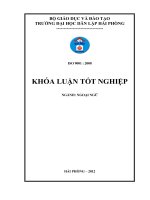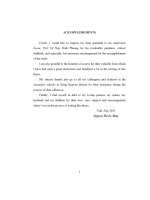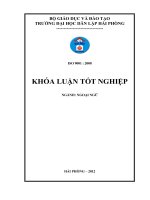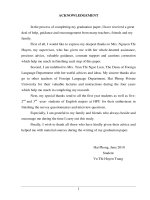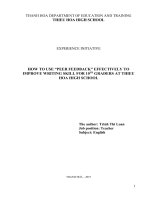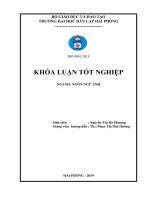A STUDY ON ONE TECHNIQUE TO IMPROVE CONVERSATIONAL SKILL FOR OPERATIONAL STAFF AT SOMERSET GRAND HANOI
Bạn đang xem bản rút gọn của tài liệu. Xem và tải ngay bản đầy đủ của tài liệu tại đây (320.48 KB, 49 trang )
VIETNAM NATIONAL UNIVERSITY, HANOI
COLLEGE OF FOREIGN LANGUAGES
DEPARTMENT OF POST-GRADUATE STUDIES
PHAN THI HONG DUNG
A STUDY ON ONE TECHNIQUE TO IMPROVE CONVERSATIONAL SKILL FOR
OPERATIONAL STAFF AT SOMERSET GRAND HANOI
NGHIÊN CỨU MỘT THỦ THUẬT NHẰM NÂNG CAO KỸ NĂNG
NÓI CHO NHÂN VIÊN THUỘC BỘ PHẬN VẬN HÀNH TẠI
SOMERSET GRAND HÀ NỘI
M. A. MINOR THESIS
FIELD: ENGLISH METHODOLOGY
CODE: 601410
SUPERVISOR: TO THI THU HUONG, Ph.D
HANOI - 2008
DECLARATION
I certify that this essay is entirely my work. I have provided fully documented references to the
work of others. The material in this essay has not been submitted for assessment in any other
formal course of study.
Phan Thi Hong Dung
ACKNOWLEDGEMENTS
I would like to express my deepest thanks to my beloved supervisor Dr. To Thi Thu Huong for
the invaluable support, guidance, and timely encouragement she gave me while I was doing this
research. I am truly grateful to her for her advice and suggestions right from the beginning
when this study was only in its formative stage.
I would also like to send my sincere thanks to my colleagues in Somerset Serviced Residences,
Hanoi who have helped me in providing the teaching materials, answering the survey
questionnaire and making constructive and insightful comments as well as suggestions for this
paper. My sincere thanks also go to all the teachers of the Department of Post graduate Studies
at Hanoi College of Foreign Languages, Vietnam National University for their profound
knowledge, useful materials which have inspired and facilitated me much throughout the
course.
I also own an enormous debt of gratitude to Ms. Ngo Thanh Thuy for her invaluable
enthusiasm and encouragement during my course.
Last but not least, I owe mother and my husband for their continuous support, they covered all
the housework and looked after my child for me to contribute totally my time on this research.
ABSTRACT
Conversational English is crucial in office communication at Somerset Grand Hanoi and it’s
still a big concern of Somerset Management Board. On the way to find solutions for English
training in the company, one technique has been approved to be very effective to improve
conversational skill for operational staff in using “Practical Situations”. This study focuses on
how researcher uses “Practical Situations” effectively in English training. And what are the
most frequently happening practical situations at Somerset Grand Hanoi? The subjects involved
in the study were 23 operational staff from three departments: Housekeeping, Engineering,
Security, 12 heads of departments were invited to join survey, to answer the questionnaires, to
participate in the interview, and to provide the source for observation.
LIST OF ABBREVIATIONS
SGH: Somerset Grand Hanoi
HOD: Head of department
ESL: English second language
ESP: English for specific purpose
CBI: Content-based instruction
OJT: On job training
BCS: Basic conversational standard
CLT: Communicative language teaching
TABLE OF CONTENTS
Declaration
…………………………………………………………………….
Acknowledgements ………………………………………………………………..
Abstract ……………………………………………………………………………
List of abbreviation ………………………………………………………………...
Table of content …………………………………………………………………….
PART I: INTRODUCTION ………………………………………………………
1. Rationale …………………………………………………………………
2. Aims of the study …………………………………………………………
3. Research questions ……………………………………………………….
4. Methods of the study …………………………………………………….
5. Scope of the study ……………………………………………………….
6. Design of the study ………………………………………………………
PART II: DEVELOPMENT ……………………………………………………..
Chapter 1: Literature review ……………………………………………………..
1. Conversation theory ……………………………………………………….
2. Communicative language teaching ……………………………………….
2.1 Content-based instruction (CBI) …………………………………….
2.2 Principles of teaching oral skill ……………………………………….
2.3 Techniques to teach oral skill …………………………………………
3. Adult learning theory ………………………………………………………
4. Current English training programs for operational staff at
Somerset Grand Hanoi ………………………………………………………
4.1 The training program ……………………………………………………
42. The required English standards …………………………………………
Chapter 2: Methodology ……………………………………………………………..
1. Rational for choosing action research ……………………………………….
2. Steps of action ………………………………………………………………
3. Participants
……………………………………………………………….
4. Instruments ………………………………………………………………….
5. Procedure of data collection ………………………………………………..
5.1 Questionnaire survey ………...………………………………………….
5.2 Interviews …………..……………………………………………………
5.3 Observation …………………….………………………………………
6. Data analysis …………………………………………………………..……
Chapter 3: Findings and Discussion ………………………………………….……
1.
How do trainers use the practical situations in improving
conversational skill for operational staff at SGH? ……………………
2.
Effectiveness of using Practical situations in improving
Conversational skill for Operational staff ……………………………
3.
Discussions: How to use these practical situations effectively
for training staff? ……………………………………………………..
PART III: CONCLUSION ………………………………………………………….
1. Summary of main findings ……………………………………………….
2. Limitation of the study ……………………………………………..…….
3. Suggestions for further research …………………………………………
REFERENCES …………………………………………………………………….
APPENDIX 1 ………………………………………………………………………..
APPENDIX 2 ………………………………………………………………………
APPENDIX 3 ………………………………………………………………………
APPENDIX 4 ……………………………………………………………………….
PART I: INTRODUCTION
1. Rationale
No one can deny the universality of English. Outside English-speaking countries, English
has become a compulsory component of office communication in many countries. This
trend also applies in Vietnam. At Somerset Grand Hanoi, English is a MUST for all staff as
it is considered to be the most useful and effective tool to communicate with customers. So,
the company always invests time and money in improving conversational skills for its staff.
However large the investment is, in fact, the conversational skills of operational staff still
do not meet the job requirements. It is a big problem for the company, because the staff
conversational
competence
directly
and
seriously
affects
the
service.
Many
misunderstanding happens at work. For example, once a guest ordered to change one queen
bed into twin beds for their two children. When the task was transferred to a housekeeping
staff, she immediately brought the bed sheets to the room to change for the guest. That
guest was very angry because his order was misunderstood and thus, wasted his time.
Another example is, when a guest wanted to borrow an “adapter”, a receptionist quickly
called “a doctor” for him. These mistakes seem to be funny but they badly affect the
professionalism of the company which is famous for leading international standard service
in hospitality industry. As a person in charge of staff training the researcher finds it a big
problem. How to improve conversational skills for operational staff? How to confirm that
their English speaking skills meet the job requirement to satisfy guests’ expectations, needs
and wants? These questions whirl in her mind all the time.
After 2 years of conducting English training for the staff, she has used many textbooks
which are available in the market such as: New Interchange, New Headway, Be My Guest
(Francis O’Hara) but the final results still have not met her expectations as well as the job
requirements. Many pilot courses have been conducted with the help of many experts as
well as data surveyed from staff and customers. After all, one technique has been found to
be more effective in improving conversational skills for her operational staff. That is using
practical situations from their daily work to help them develop the necessary English
conversational skills for their very work. Thus, this current study is conducted to shed light
on the effectiveness of this technique in the training and development of English
conversational skills for operational staff at Somerset Grand Hanoi (SGH) and other similar
institutions in Vietnam or elsewhere.
2. Aims of the study
The study explores the effectiveness of using practical situations to improve English
conversational skills for operational staff at Somerset Grand Hanoi (SGH). The major aims
of the study are to:
-
Conduct an analysis of the current situation of training English conversational skills for
operational staff at SGH with particular reference to the technique of using practical
situations.
-
Pilot the use of practical situations (that are essential for communication in English by
operational staff at SGH) for training conversational skills for these staff to find out
how effective the technique is.
-
Finalize a package of 10 most applicable practical situations with suggestions for
effective use of these practical situations in training operational staff to improve their
English conversational skills.
3. Research questions
In order to achieve the above-mentioned aims, the following research questions were
formulated for investigation:
1. How do trainers use the technique of practical situations for improving conversational
skills of operational staff at SGH? What are the 10 most applicable practical situations?
2. How effective is the use of these practical situations for improving conversational skills
for SGH operational staff?
4. Method of the study
The method used in the study is action research. According to Wallace (1998, quoted in
Mackey & Gass 2005: 216) action research is “basically a way of reflecting upon your
teaching...by systematically collecting data on your everyday practice and analyzing it in order
to come to some decisions about what your future practice should be”. The goal of this is to
improve teaching and learning. In this study, the goal of the action is to improve conversational
skills for SGH operational staff.
Five steps for the action were identified and implemented. They are:
1. Identify problems/concerns: for this study, it is how to improve English conversational
skills for SGH operational staff;
2. Conduct a preliminary investigation to gather information on how trainers use the
technique of practical situations for improving conversational skills of operational staff
at SGH and what practical situations can be used in training conversational skills for the
target staff;
3. Pilot the use of the technique and form assumptions about the effectiveness of the
technique and identify 10 most applicable practical situations for dissemination;
4. Evaluate the effects of the practice; i.e. the effectiveness of the technique of using
practical situations for improvement of conversational skills for SGH operational staff;
5. Disseminate the results of the process in the form of a Training Handbook containing
the 10 most applicable work situations with practical guidelines for trainer.
For collection of data, questionnaire survey was used to explore current use of practical
situations in training English conversational skills for operational staff at SGH as well as to
identify work related topics/situations and appropriate learning tasks and activities.
Interviews with 10 loyal customers, who have stayed at Somerset Grand Hanoi for more than 1
year, were also conducted to find out the required conversational skills and typical
communication situations for SGH operational staff at work (pre-training) as well as guests’
level of satisfaction with target staff’s conversational skills after the pilot training.
On the basis of the collected data, the researcher comes to a conclusion about the applicability
and effectiveness of using practical situations in improving conversational skills for operational
staff. A training course employing the identified practical situations for improvement of
targeted staff is designed on the basis of the existing course and piloted. She then finalized a
package of highly work-related situations and suggested methods to use these situations in
training conversational skills for operational staff at SGH.
Observations by the Heads of departments, immediate supervisors and the co-trainer after the
pilot course were sources of information on the evidence of improvement in English
conversational skills of SGH operational staff, indicators of the effectiveness of the technique.
5. Scope of the study
This research aims to explore the effectiveness of using practical situations in improving
English conversational skills for operational staff at Somerset Grand Hanoi. These staff
includes people working at Front Office, Security, Engineering, and Housekeeping.
Within the limited framework of a minor thesis, the present study can only focus on the
Security, Engineering, and Housekeeping staff as, for them; English conversational skills are
the most critical for maintaining an excellent image and success for the company. Besides, their
English proficiency level is still very low, that is seriously hampers their work performance.
6. Design of the study
The study comprised three parts: Introduction, Development and Conclusion.
Part 1 (Introduction) presents the rationale, aims, scope, methodology and design of the study.
Part 2 (Development) consists of four chapters:
Chapter 1: Literature review on Conversation theory; Communicative language
teaching (Practical situations); Adult learning; Current English training programs for
operational staff at SGH
Chapter 2: Methodology detailing rationale for choosing Qualitative research approach,
Participants, Questionnaire survey, Interviews, Observations, and Data Analysis procedures.
Chapter 3: Findings and discussion of the results.
Part 3 (Conclusion) provides conclusions on the research and makes suggestions for further
study.
PART II: DEVELOPMENT
Chapter 1: Literature review
In this chapter, relevant literature and theoretical framework of this study are presented, which
include (1) Conversation theory, (2) Communicative language teaching with focus on:
Communicative competence, Principles of teaching speaking, Techniques of teaching speaking
and using practical situations. (3) Adult learning, (4) Current English training programs for
operational staff at Somerset Grand Hanoi.
1. Conversation theory
There are many definitions of conversation theory. Some of the commonly cited are:
From Wikipedia, the free encyclopedia: Conversation Theory regards social systems as
symbolic, language-oriented systems where responses depend on one person's interpretation of
another person's behavior, and where meanings are agreed through conversations. But since
meanings are agreed, and the agreements can be illusory and transient, scientific research
requires stable reference points in human transactions to allow for reproducible results. Pask
found these points to be the understandings which arise in the conversations between two
participating individuals, and which he defined rigorously.
Conversation Theory describes interaction between two or more cognitive systems, such as a
teacher and a student or distinct perspectives within one individual, and how they engage in a
dialog over a given concept and identify differences in how they understand it.
Conversation Theory came out of the work of Gordon Pask on instructional design and models
of individual learning styles. In regard to learning styles, he identified conditions required for
concept sharing and described the learning styles holist, serialist, and their optimal mixture
versatile. He proposed a rigorous model of analogy relations.
From
Conversation
Theory
–
Gordon
Pask
at
Conversation Theory as developed by
Pask originated from this cybernetics framework and attempts to explain learning in both living
organisms and machines. The fundamental idea of the theory was that learning occurs through
conversations about a subject matter which serves to make knowledge explicit. Conversations
can be conducted at a number of different levels:
Natural language (general discussion)
Object languages (for discussing the subject matter)
Metalanguages (for talking about learning/language)
Along this vein, the conversational skills for operational staff at SGH (a full-serviced apartment
hotel) comprise not only English but also hospitality-related skills. So in this study, the
researcher intends to use elements of both Natural language and Object language to improve
conversation skills for the targeted staff.
In order to facilitate learning, Pask argued that the subject matter should be represented in the
form of structures which show what is to be learned. These structures exist in a variety of
different levels depending upon the extent of the relationships displayed. The critical method
of learning, according to Conversation Theory, is "teachback" in which one person teaches
another what they have learned.
Pask identified two different types of learning strategies:
Serialists – Progress through a structure in a sequential fashion
Holists - Look for higher order relations
For students to learn a subject matter, they must learn the relationships among the concepts.
For teachers, the explicit explanation of the subject matter facilitates student understanding
(e.g., use of teachback technique). However, students differ in their preferred manner of
learning
relationships
(serialists
versus holists), so a thorough understanding of
students/trainees is essential to teaching/training success.
Given its relevance and effective application, “Teachback” will be applied to develop the
program for improving conversational skills for SGH operational staff. At the completion of the
study, a training guideline for trainers will be published based on the findings so that a Train
the Trainer model could be used.
2. Communicative language teaching
Communicative language teaching began in Britain in the 1960s as a replacement to the earlier
structural method, called Situational Language Teaching. This was partly in response to
Chomsky's criticisms of structural theories of language and partly based on the theories of
British functional linguistic, such as Firth and Halliday, as well as American sociolinguists,
such as Hymes, Gumperz and Labov and the writings of Austin and Searle on speech acts.
Communicative language teaching (CLT) has become the accepted orthodoxy theory of TEFL
over the past ten years or more, and many, but not all, general courses include communicative
goals, communicative practice or communicative methodology. Its theoretical base, according
to Richards and Rodgers (1986/2000:71), includes these characteristics:
1. Language is a system for the expression of meaning.
2. The primary function of language is for interaction and communication.
3. The structure of language reflects its functional and communicative uses.
4. The primary units of language are not merely its grammatical and structural features, but
categories of functional and communicative meaning as exemplified in discourse.
Communicative language teaching makes use of real-life situations that necessitate
communication. The teacher sets up a situation that learners are likely to encounter in real life.
Unlike the audiolingual method of language teaching, which relies on repetition and drills,
communicative approach can leave learners in suspense as to the outcome of a class exercise,
which will vary according to their reactions and responses. The real-life simulations change
from day to day. Learners’ motivation to learn comes from their desire to communicate in
meaningful ways about meaningful topics.
Berns (1984) explains Firth’s view that “language is interaction; it is interpersonal activity and
has a clear relationship with society. In this light, language study has to look at the use
(function) of language in context, both its linguistic context (what is uttered before and after a
given piece of discourse) and its social, or situational, context (who is speaking, what their
social roles are, why they have come together to speak)”(Berns,1984:5).
2.1 Content-based instruction (CBI)
From Wikipedia, CBI approach is comparable to English for Specific Purposes (ESP). The goal
of CBI is to prepare students to acquire the languages while using the context of any subject
matter so that students learn the language by using it within the specific context. Rather than
learning a language out of context, it is learned within the context of a specific subject.
2.2 Principles of teaching oral skill
1. Take account of the student as a person
be sensitive, sympathetic and encouraging
select material that is motivating and within their ability
2. Reduce anxiety by moving from easy to less easy
help students take short turns
provide a familiar, private environment
use information-gap activities
try the activity yourself first!
3. Maintain a careful balance between accuracy and fluency
provide practice in pronunciation, words stress, sentence stress, intonation and
pause
provide opportunities for fluent use of speech
4. Provide a good model for students to imitate
learn to speak English acceptably yourself!
repeatedly use target speech patterns
consciously teach correct pronunciation, etc
5.
Vary classroom interaction modes
individual to whole class
pair work
group work
6.
Give clear instructions
speak loudly, slowly and clearly
demonstrate the proposed task
7.
Monitor student activity continuously
encourage those who find the activity difficult
note down common and recurring errors
praise students who perform well or try hard
8.
Prepare well for class
make a checklist of things to obtain
9.
make a checklist of things to do
Handle errors sensitively and effectively
ignore performance errors
ignore errors that are repeated
correct errors in language areas that you recently taught
correct errors that might shock listeners (e.g. children)
correct errors in structures that need to be used frequently by the student (e.g.
*‘What means this?’ instead of ‘What does this mean?’)
correct errors through modeling (S: *M’s mother was died. T: M’s mother was
dead.)
correct errors through flooding to ‘wash them out’!
correct errors through explanation
2.3 Techniques to teach oral skill
It is very important for teachers to adopt as many techniques as possible to let students to
practice English in class. Here are some possible techniques (compiled by To et al, 2006):
Role Play
One way of getting students to speak is role-playing. Students pretend they are in various social
contexts and have a variety of social roles. In role-play activities, the teacher gives information
to the learners such as who they are and what they think or feel. Thus, the teacher can tell the
student that "You are David, you go to the doctor and tell him what happened last night, and…"
(Harmer, 1984)
Simulations
Simulations are very similar to role-plays but what makes simulations different than role plays
is that they are more elaborate. In simulations, students can bring items to the class to create a
realistic environment. For instance, if a student is acting as a singer, she brings a microphone to
sing and so on. Role plays and simulations have many advantages. First, since they are
entertaining, they motivate the students. Second, as Harmer (1984) suggests, they increase the
self-confidence of hesitant students, because in role play and simulation activities, they will
have a different role and do not have to speak for themselves, which means they do not have to
take the same responsibility.
Information Gap
In this activity, students are supposed to be working in pairs. One student will have the
information that other partner does not have and the partners will share their information.
Information gap activities serve many purposes such as solving a problem or collecting
information. Also, each partner plays an important role because the task cannot be completed
if the partners do not provide the information the others need. These activities are effective
because everybody has the opportunity to talk extensively in the target language.
Brainstorming
On a given topic, students can produce ideas in a limited time. Depending on the context, either
individual or group brainstorming is effective and learners generate ideas quickly and freely.
The good characteristics of brainstorming is that the students are not criticized for their ideas so
students will be open to sharing new ideas.
Storytelling
Students can briefly summarize a tale or story they heard from somebody beforehand, or they
may create their own stories to tell their classmates. Story telling fosters creative thinking. It
also helps students express ideas in the format of beginning, development, and ending,
including the characters and setting a story has to have. Students also can tell riddles or jokes.
Interviews
Students can conduct interviews on selected topics with various people. It is a good idea that
the teacher provides a rubric to students so that they know what type of questions they can ask
or what path to follow, but students should prepare their own interview questions. Conducting
interviews with people gives students a chance to practice their speaking ability not only in
class but also outside and helps them becoming socialized. After interviews, each student can
present his or her study to the class.
Practical situations
Learners can practice conversational skill in situations such as asking and giving directions in a
city and ordering the services in hotel. For example, after mechanically drilling the questionanswer pattern asking for directions to a specific location and the other giving directions
according to a map.
3
Adult learning theory
Speck (1996) notes that the following important points of adult learning theory should be
considered when designing learning activities for adults:
"Adults will commit to learning when the goals and objectives are considered realistic
and important to them. Application in the 'real world' is important and relevant to the
adult learner's personal and professional needs.
Adults want to be the origin of their own learning and will resist learning activities they
believe are an attack on their competence. Thus, professional development needs to give
participants some control over the what, who, how, why, when, and where of their
learning.
Adult learners need to see that the professional development learning and their day-today activities are related and relevant.

